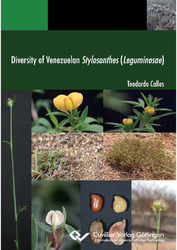| Departments | |
|---|---|
| Book Series (96) |
1378
|
| Nachhaltigkeit |
3
|
| Gesundheitswesen |
1
|
| Humanities |
2365
|
| Natural Sciences |
5406
|
| Mathematics | 229 |
| Informatics | 319 |
| Physics | 980 |
| Chemistry | 1363 |
| Geosciences | 131 |
| Human medicine | 243 |
| Stomatology | 10 |
| Veterinary medicine | 108 |
| Pharmacy | 147 |
| Biology | 835 |
| Biochemistry, molecular biology, gene technology | 121 |
| Biophysics | 25 |
| Domestic and nutritional science | 45 |
| Agricultural science | 1004 |
| Forest science | 201 |
| Horticultural science | 20 |
| Environmental research, ecology and landscape conservation | 148 |
| Engineering |
1793
|
| Common |
98
|
|
Leitlinien Unfallchirurgie
5. Auflage bestellen |
|
Advanced Search
Diversity of Venezuelan Stylosanthes (Leguminosae) (English shop)
Teodardo Calles (Author)Preview
Table of Contents, Datei (64 KB)
Extract, Datei (160 KB)
Stylosanthes is a mainly Neotropical legume genus. South America is considered as the main centre of diversity of Stylosanthes species whose centre of origin probably lies also here. Stylosanthes is of economic importance; currently, some species are used in Australia, tropical Asia, sub-Saharan Africa and tropical America as forage, soil cover, for soil improvement and for the production of concentrate feed for livestock.
The genus comprises about 25 species but in the literature estimates of up to 50 species can be found. This is a consequence of the high morphological plasticity of Stylosanthes species leading to uncertainties regarding species delimitation. Differences among Stylosanthes taxonomical revisions are due to the respective author’s species concept, i.e., based on floral morphology versus vegetative characters. An example of such different viewpoints is the so-called Stylosanthes guianensis complex where most members are treated as separate species by some authors and as botanical varieties by others.
In the last two decades, scientists have started to use DNA data in an attempt to overcome the taxonomical problems of the genus Stylosanthes. However, so far, the combined analysis of both morphological and genotypic characteristics in taxonomic studies has not been used in Stylosanthes, neither in a supplementary nor in a complementary manner.
Venezuela has a high Stylosanthes species richness and 12 species have been reported in the country, namely S. capitata, S. diartha, S. gracilis, S. guianensis, S. hamata, S. humilis, S. mexicana, S. nervosa, S. scabra, S. sericeiceps, S. tuberculata and S. viscosa. Until now, the taxonomic status of some of these species remains unclear and information about the distribution of the species in the country is scarce. However, for actions like the sound management of biological diversity, including its conservation, a good understanding of the taxonomy and geographic distribution of the species is needed.
Consequently, the objectives of this study were to: (a) produce a taxonomic inventory of Stylosanthes species occurring in Venezuela, (b) create an easy-to-handle identification key and illustrations of Venezuelan Stylosanthes species, © document the geographic distribution of Stylosanthes in the country, (d) determine Stylosanthes species richness in Venezuela, and (e) assess delimitation of Venezuelan Stylosanthes species using both genetic markers and morphological characters.
For this research, over 1000 specimens from 35 herbaria were examined and, additionally, passport data of 416 germplasm accessions collated. For the biogeographic assessment, the Venezuelan mainland was divided into 1345 grid cells (15’ × 15’ latitude and longitude). To obtain molecular data on Stylosanthes species, the SSR marker technique was used.
As a result of this study, two new species were described (i.e., S. falconensis and S. venezuelensis) and a total of 11 Stylosanthes species were identified for Venezuela: S. angustifolia, S. capitata, S. falconensis, S. gracilis, S. guianensis, S. hamata, S. humilis, S. scabra, S. sericeiceps, S. venezuelensis and S. viscosa, three of them being endemic to the country.
There were three nomenclature problems that this research resolved, beyond its concentrating on Venezuelan species: (a) clarification of the correct names of the two Stylosanthes sections, (b) elucidation of the controversy on the generic type of Stylosanthes, and © clarification concerning the rank of the epithet gracilis.
Biogeographical analysis indicates that the genus Stylosanthes is widely distributed in Venezuela and has a large range size (19.55% of all mainland grid cells), occurring mainly in lowland regions. The greatest species richness is found in an area of the Eastern Plains (7–10° latitude North and 62–65° longitude West) which is probably part of the genus’ centre of origin. The endemic species were classified as “very rare”; thus protection strategies, that might include in-situ and ex-situ conservation, are suggested.
SSR markers proved to be a useful tool in diversity studies within the genus Stylosanthes. Comparison between results of morphological and molecular analyses showed that many relationships resulting from the morphological analysis are corroborated by molecular data. However, for some species additional studies are needed.
| ISBN-13 (Printausgabe) | 3954040697 |
| ISBN-13 (Hard Copy) | 9783954040698 |
| ISBN-13 (eBook) | 9783736940697 |
| Final Book Format | A5 |
| Language | English |
| Page Number | 228 |
| Lamination of Cover | matt |
| Edition | 1 Aufl. |
| Volume | 0 |
| Publication Place | Göttingen |
| Place of Dissertation | Hohenheim |
| Publication Date | 2012-04-10 |
| General Categorization | Dissertation |
| Departments |
Biology
|








